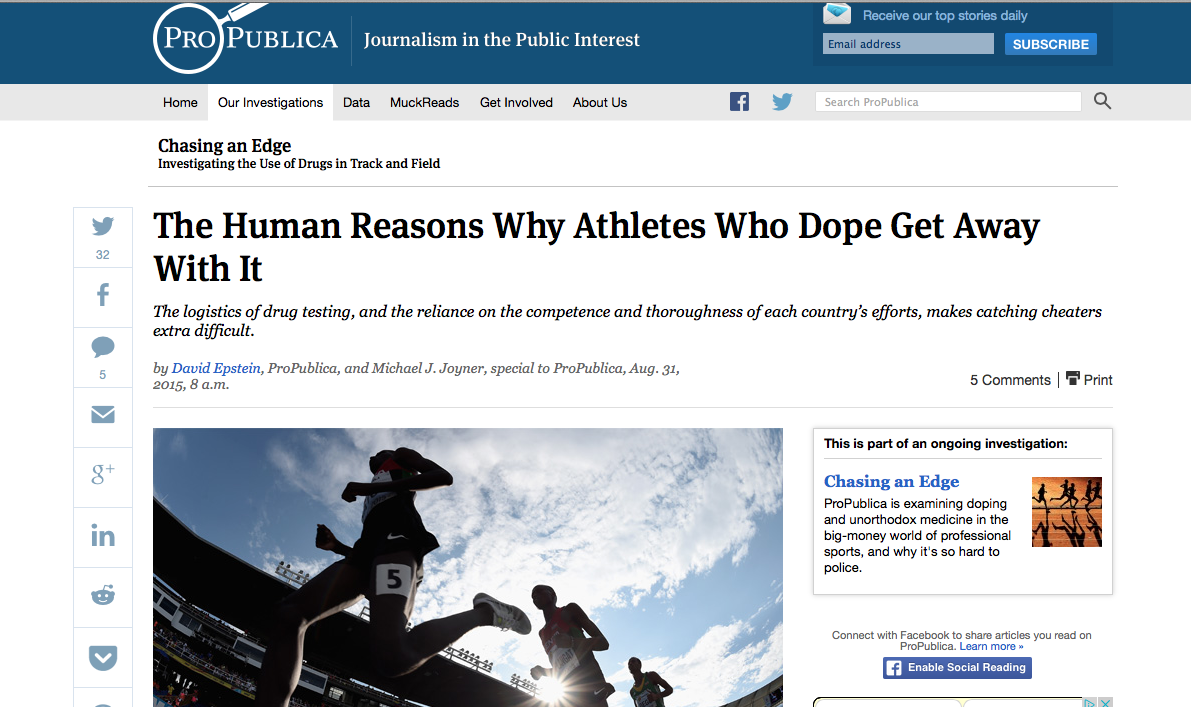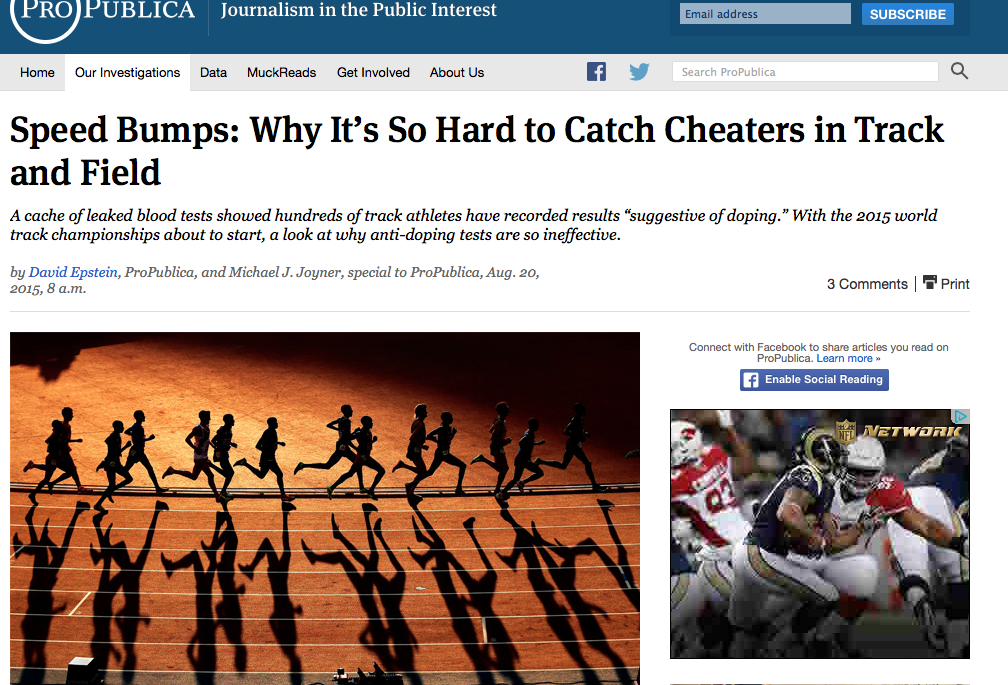Archive for the ‘Elite Sports Performance’ Category
Happy Holidays Coach Murray
The subject of good coaches and how important they are came up in one of the groups I have an ongoing e-mail dialogue with. The conversation stimulated Alex Hutchinson to generate an outstanding post for Runner’s World. As a part of it I shared some thoughts about Dave Murray who was my coach at the University of Arizona from 1977-81. The link is below. If you had a coach who played a key role in your life, this holiday season would be a good time to let them know they mattered.
click for link
The Biological Passport & the Paula Radcliffe Controvery
The great English marathon runner Paula Radcliffe is under suspicion for doping based on some leaked lab values from drug tests conducted sometime in the 2000s. Radcliffe has run the three fastest marathons by a woman and my colleagues Sandra Hunter, Andy Jones and I have argued that her world record of just over 2:15 is essentially a sub “2-hour” marathon for women.
There is a lot of controversy about this and about the release of the blood test scores and just how transparent Radcliffe has been with her data. Here is an excerpt from a Sky News report:
“Radcliffe, who this week spoke out to deny doping, insists test results included in a leaked database were cleared by the International Association of Athletics Federations (IAAF) and can all be explained by the circumstances in which they were taken. She says the test results, seen by Sky News, all fall below normal levels for samples given following altitude training, and she believes this destroys the case against her.
Radcliffe’s “off-scores”, the measures used to gauge an athlete’s blood values, in the three tests were 114.86, 109.86 and 109.3. Anything above 103 recorded by a female athlete can be a trigger for investigation and target-testing, but the ‘normal’ threshold can rise for a number of reasons, including altitude training and tests taken immediately after extreme exertion.
Radcliffe says all three samples were taken after periods of altitude training and two, including the highest, were taken immediately after she had raced. Radcliffe says these factors explain the figures.”
What is an “Off Score?”
I have always been a little confused about what an “off score” is perhaps because in clinical medicine we think about the hemoglobin concentration (Hb, hemoglobin is the substance in red blood cells that carries oxygen and increased hemoglobin in the blood is why blood doping and the drug EPO work to improve endurance). We also sometimes think about other parameters like the reticulocyte count which is an index of how rapidly the body is making new red blood cells. To understand how the values are used to create the scores used in the Athlete Biological Passport I e-mailed my colleagues Drs. Jim Stray-Gundersen and Ben Levine. Jim and Ben are two of the world’s leading experts on altitude training and legal ways to increase endurance performance in humans. Jim has also been involved in a number of the studies that led to the current approach to testing. As he followed the traffic Ben Levine simply said:
“I have nothing to add to Jim’s erudite discussion. Mike – could you put this on your blog?”
So here are some excerpts of our e-mail exchange from late last week.
E-mail #1: Subject: ABP scores and Paula
Jim, can you explain these scores to me? What was her Hb and what was her reticulocyte count?
Response #1 Hi Mike, if you are talking about Paula’s OFF scores from the hematologic passport, I don’t know what the values were, but it is a function of a low reticulocyte (retic) count and a high Hb. So when one gets a transfusion, one has a high (or higher) Hb and the bone marrow shuts off (or decreases) the rate of producing new retics. Here is a link to a detailed explanation by Ross Tucker.
The calculation is: is Hemoglobin x 10 – 60 x (square root of the reticulocyte %). “Normal” OFF scores are between 80-110.
Essentially, we are looking at abnormally accelerating or decelerating the bone marrow and coming up with a “score” that is associated with a probability of only being due to various blood doping practices. These scores were developed from an IOC study, that I was involved with, where we surveyed blood values in over a 1000 international caliber athletes from around the world (all ethnic and racial groups form endurance sports) and then 3 different blood doping trials (in Norway (which I did), Australia and China). Originally, we had an ON score (starting an ESA – erythropoiesis-stimulating agent) and an OFF score (transfusions or stopping an ESA), but the normal range of the ON score overlapped significantly with starting an ESA, so we just went with the OFF score where there was almost no overlap.
I had also (separately) come up with something called the SAFE Program (Safe and Fair Events) which we used in ISU (international skating federation) and trialed in FIS, IBU, IAAF and UCI in 1999-2001. I used a Z score for both hemoglobin and % reticulocytes to detect the degree of abnormality. The current ABP system is an evolution of my work and the original ON/OFF work centered in Australia.
So there is a one off chance of catching someone with a sufficiently abnormal score, but then if you take serial measurements and create a “passport” of scores over time and you have normal scores followed by an abnormal score and back again, that is a much more sensitive test. It is conceivable if you are very severely dehydrated which can raise Hb, but not % retics to get an abnormal OFF score (e.g. Hb going from 14 to 17, with retics staying at 1% causes the score to go from 80 to 110), but even that degree of dehydration produces a score still within the normal limits. In all our altitude studies, we have never seen an abnormal OFF score being at an altitude camp and coming down to sea level.
Originally, we intended to use these scores to deter cheating and not allow a start in an important race (avoiding the cost and embarrassment of a doping finding). The intent was to “herd” cheaters into safer and less effective behaviors. We would test everyone the day before the competition, as well as, random out of competition testing. This program would make people think twice about cheating and would catch people using massive doses (which are both dangerous and provide a huge advantage) and prevent them from competing. To me this program cleans up a lot of sport ahead of time and is a different paradigm than the “cops and robbers” anti-doping game.
It is possible to use “micro-dosing” and stay below the radar, but when doing this, it is unlikely to be harmful to health and the advantage can be negated by legal, ethical means, like proper HiLo training. The effect is safe and fair events reducing the extent of doping and letting athletes decide that they can be clean and win.
Enjoy! Jim
E-mail #2
Jim, very helpful…… but this gets a bit like other derived variables sometimes better to actually just focus on Hb and retic count.
Response #2 definitely, there are some potential confounding variables. That is why we look at serial measurements in the same person with their own normal values, take into consideration the circumstances and. The reason to come up with derived variables is that it allows us to take the changes in Hb and changes in retic % into one consideration.
Since your first email, I looked up what the values were that raised suspicion in Paula. There were apparently three were between 110 -114. None of these are really that abnormal and all three have logical explanations. Apparently, they were correctly handled and found by experts to not indicate doping. The system worked correctly. This is an example of the (insufficiently informed) media and public casting hurtful accusations incorrectly and inappropriately. Paula is due a public apology.
One final comment, there are also individuals with high Hb values on a genetic basis. We developed a procedure involving looking at family members and historical records back into childhood to provide a “letter of exception” when the genetic basis is documented.
Jim
Summary: I would like to thank Dr. Stray-Gundersen for his excellent tutorial on this topic and his permission to post our exchange. His ideas about focusing behavioral incentives and better systems amplified by testing to deter doping are excellent and consistent with my own ideas about how to address this complex problem.
Is Dibaba’s 1500m Record “Believable”?
A couple of weeks ago Ethiopia’s Genzebe Dibaba broke the women’s world record for the 1500m run with a time 3:50.07. The believability of this performance will certainly be questioned because most of the women’s world records in track and field have been stagnant for decades and date to the era of industrial strength doping in the 1980s and 90s. The 1500 record was set by a Chinese athlete in 1993 who was almost certainly doping. Many of the men’s distance running records are also “old” and occurred after the emergence of the blood boosting drug EPO in the late 1980s and before the advent of better (but far from perfect) drug testing regimens in the later 2000s.
A reasonable rule of thumb is that world records in women’s middle and long distance running “should” be on the order of about 11-12% slower than men’s. This is based on the fact that maximal aerobic power is typically that much lower in elite women than men, while other key physiological factors related to lactic acid build up and running efficiency that determine running performance are generally similar. The current fastest time by a man for 1500m in the pre EPO era was set by Said Aouita at 3:29.46 in 1985! The best time since drug testing got better is 3:26.69 by Asbel Kiprop of Kenya set earlier this year (the world record for men is 3:26 set by Hicham El Guerrouj in 1998).
Historically even better performances, but not faster times, were achieved by Jim Ryun and Kip Keino in the late 1960s. Ryun ran a 3:33.1 on a cinder track at the LA Coliseum in 1967. It was also hot that day. A modern optimally tuned track might be worth 3% and if you adjust Ryun’s performance you get an estimated time of about 3:26 and change.
An even more remarkable performance came a year later when Kip Keino ran 3:34.9 at high altitude to win the gold medal at the Mexico Olympics. Mexico City has an altitude of almost 7,400 feet (2,250m), and the best data suggests that lack of oxygen at that altitude should reduce aerobic power by about 10%. Now Keino was altitude adapted because he had spent his life in the highlands of Kenya, but adaptation only gets you so much. So if we are conservative and adjust his performance by 5% an estimated time just over 3:24 seems “possible”. Old school “point tables” from the 1960s and early 70s also suggest that the 5000m times run by Dibaba and also her world record holding sister equate to times under 3:50.
Which brings me back to Dibaba and the women’s 1500m record, her time is a little more than 12% slower than what Keino might have run and between 11 and 12% slower than the projection for Ryun. It is just over 11% slower than the best time for men since drug testing got better. There are all sorts of reasons to be suspect of any world record in sports like track and cycling and the East Africans have done their share of doping. However, given the analysis above, Dibaba’s record seems like it is at the edge of believable to me.
You are currently browsing the archives for the Elite Sports Performance category.







